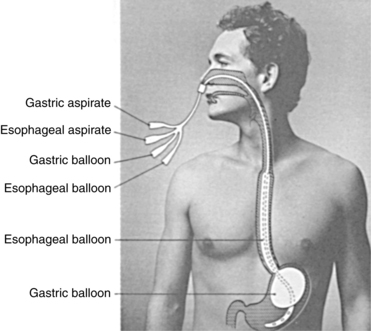Esophagogastric Tamponade Tube
Esophagogastric tamponade therapy is used to provide temporary control of bleeding from gastric or esophageal varices.2
PREREQUISITE NURSING KNOWLEDGE
• Tamponade therapy exerts direct pressure against the varices with the use of a gastric or esophageal balloon and may be used for cases that are unresponsive to medical therapy or that are too hemodynamically unstable for endoscopy or sclerotherapy.1,3
• Esophagogastric tamponade tubes are used to control bleeding from either gastric or esophageal varices. The suction lumens allow the evacuation of accumulated blood from the stomach or esophagus. The suction lumens also allow for the intermittent instillation of saline solution to assist in the evacuation of blood or clots.
• Three types of tubes are available for esophagogastric tamponade therapy. The two most common are the Sengstaken-Blakemore (C.R. BARD, Inc., Covington, Georgia) tube (Fig. 104-1) has a gastric and esophageal balloon and a gastric suction lumen. The four-lumen Minnesota tube (Fig. 104-2) has gastric and esophageal balloons and separate gastric and esophageal suction lumens. The third, the Linton or Linton-Nachlas tube, (Mallinckrodt Inc. Tyco Health Care Group, Hampshire, UK) has a gastric balloon and separate gastric and esophageal suction lumens and is used only for treatment of bleeding gastric varices. The Minnesota tube is considered the preferred tube for esophagogastric tamponade therapy because it allows for suction above and below the balloons.
• Esophagogastric tamponade tubes may be introduced via either the nasogastric or the orogastric route. The tubes are then advanced through the oropharynx and esophagus and into the stomach.
• Contraindications include esophageal strictures or recent esophageal surgery, congestive heart failure, respiratory failure, hiatal hernia, and cardiac dysrhythmias.3 Because of the risk for aspiration, the patient may need endotracheal intubation for airway protection.
• Sedation should be considered, but dosing should be individualized on the basis of the likelihood of liver injury with its concomitant alteration in the metabolism of medications. The plan for sedation is individualized with the goal of achieving patient comfort through a safe use of medications if needed.
• Head of bed (HOB) should be at least 30 to 45 degrees at all times to reduce risk of aspiration.6
EQUIPMENT
• Tamponade tube (Sengstaken-Blakemore, Minnesota, or Linton-Nachlas)
• Irrigation kit (or catheter-tip, 60-mL syringe and basin)
• Nasogastric (NG) tubes (one for Sengstaken-Blakemore tube)
• Normal saline (NS) solution for irrigation
• NS solution, 500 mL (provides weight for traction on the tube)
• Sphygmomanometer or pressure gauge
• Two suction setups and tubing
• Endotracheal suction equipment
• Emergency medications, including atropine
• Emergency equipment, including transcutaneous pacemaker and intubation equipment
Additional equipment (to have available based on patient need) includes the following:
• Rubber cube sponge (used for nasal tamponade tube placement)
• Balanced suspension traction apparatus with 1 pound of weights, 500 mL of NS solution (Fig. 104-3), or football helmet with face mask (Figs. 104-4)

Figure 104-3



